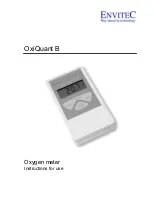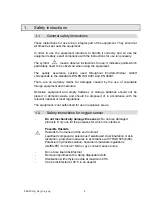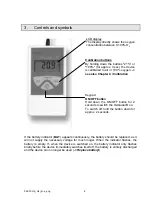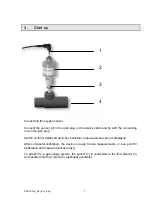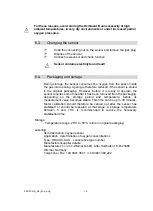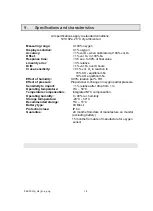
046-07-GA_Oxi_B-a_eng 11
6.
EnviteC oxygen sensor
6.1.
Function principle
The function of the oxygen sensor can be simply described as follows:
1.
The measured gas diffuses through a synthetic membrane and dissolves
in the oxygen sensor electrolyte.
2.
The electrolyte contains 2 electrodes which are connected together by
an external resistor network.
3.
The proportion of dissolved oxygen is reduced at the working electrode
(cathode). Oxidation takes place in a complementary reaction at the
second electrode (anode).
4.
The resulting internal ion current drives an external electrical current
proportional to the conversion of oxygen.
5.
The diffusion of gas molecules is a temperature-dependent process. To
compensate for this dependency, the current is converted into a
temperature-compensated voltage by means of a thermistor resistance
network.
6.2.
Sensor service life
The OxiQuant B consists of a meter and an oxygen sensor. Because the
batteries and the oxygen sensor wear out during use, the battery and/or the
sensor should be replaced if the supply voltage or the measured signal display
no longer functions. The battery and the sensor are designed so that an average
service life of approx. 2 years is provided in normal use.
The following ageing influences must be noted:
The oxygen sensor ages independently of the length of time for which the device
is switched on, dependent on temperature and the partial oxygen pressure on the
sensor’s gas-sensitive surface.
??
The minimum service life of the oxygen sensor is based on 1
oxygen percent x hours, i.e. 500,000 %O
2
h. The sensor
therefore wears out after 2 ½ years of use in ambient air or less
if it is stored or used at higher partial oxygen pressures.
??
Temperature accelerates the rate of reaction of the oxygen
sensor, and therefore has an effect on its ageing. The simplified
relationship that applies here is that the higher the temperature,
the shorter the expected service life.
??
Very dry ambient conditions also have a negative effect on the
service life of the oxygen sensor, as they accelerate the
evaporation of the electrolyte.

